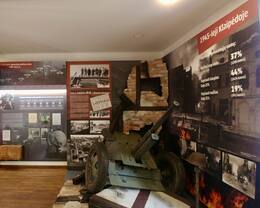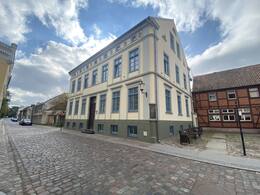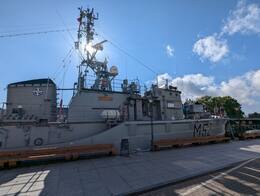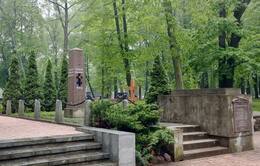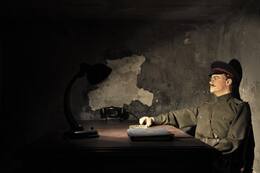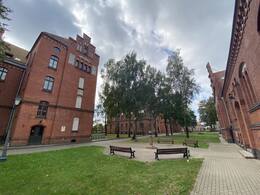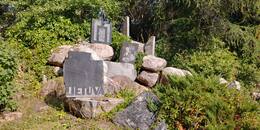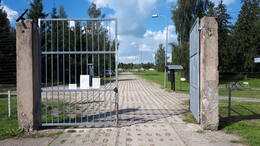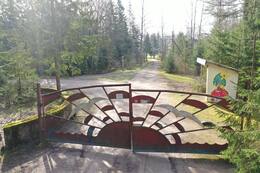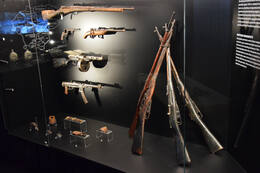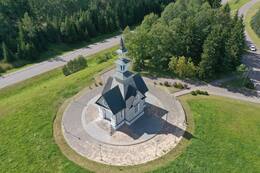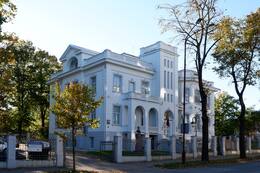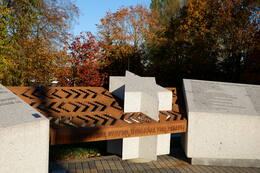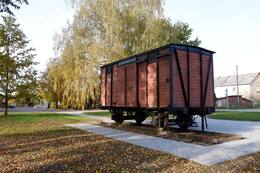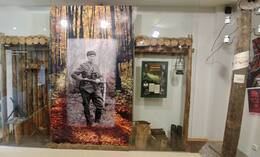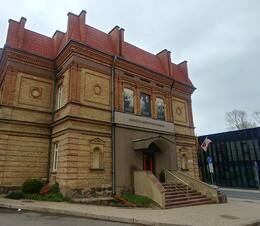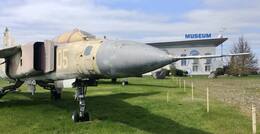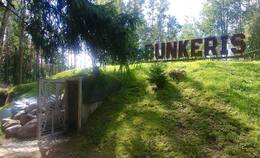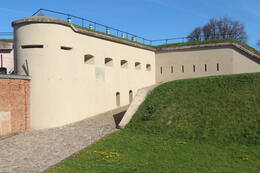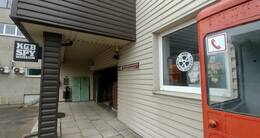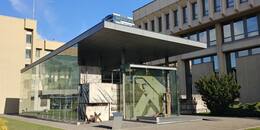Scenes of Soviet Lithuania
Exposition “Sovietmečio pėdsakais” (“In the Footsteps of the Soviet Era”) at the History Museum of Lithuania Minor
The exposition is located in the central part of Klaipėda. When the Soviets occupied Lithuania in 1940, Klaipėda and the region of Klaipėda were already part of the German Reich. In January 1945, Klaipėda was captured by the Red Army. According to the registration data of the war commandant, only 28 civilians were left in the town at the time. The new Soviet period in Klaipėda began. One repressive regime was replaced with another.
The exposition “Sovietmečio pėdsakais” (“In the Footsteps of the Soviet Era”) aims to reflect the Soviet era and the changes that began in the late 1990s and to help understand the complex Soviet atmosphere. The exposition tells the story of the new inhabitants, the construction of the “socialist” Klaipėda, the Soviet ideology and propaganda efforts, the desire to destroy everything that was national, folk and civic, as well as religious consciousness. Different stories and themes are revealed: the interior of a Soviet-era living room of an intelligent person illustrates the everyday life of people of that time; an improvised “red corner” and the Soviet slogans reflect the methods and banality of Soviet propaganda; a computer terminal demonstrates the construction of Blessed Virgin Mary, Queen of Peace Church in Klaipėda and its fate in 1957–1963, etc.
French Commissariat in Klaipėda
The French Commissariat is located in the Old Town of Klaipėda. After the First World War, the Treaty of Versailles separated the Klaipėda region (Memel Gebiet or Territoire de Memel) from Germany. In January 1920, the administration of the district was taken over from the German representative by the French-appointed administrator, Brigadier-General, Dominique Odry, who settled at 3 Perkasų Street (now Sukilėlių Street). Thus, from 1920–1923, the Prefecture became the seat of the French Commissariat General and the most important state institution in the Klaipėda region.
On 10–15 January 1923, a well-organised and successfully executed military operation organised by the Lithuanian government, the army and the Riflemen Union took place, which was known as the “Klaipėda County Uprising” for a long time. After that, Klaipėda was annexed to Lithuania. During the military operation, the 2nd (Pagėgiai) Battle Group of Special Task Force, led by Mykolas Kalmantas-Bajoras, broke into and occupied the Prefecture building. High Commissioner Gabriel Petisné was forced to raise the white flag and surrender.
In cultural history, the Prefecture is associated with the victory of the “rebels”, which was the final part of the annexation of Klaipėda. Therefore, the theatrical storming of the prefecture, which is imitated by the reconstructors of war history, is depicted when the annexation of Klaipėda to Lithuania is commemorated.
Mine countermeasures ship-museum M52 "Sūduvis"
The M52 “Sūduvis” mine countermeasures ship-museum is located on the Karališkoji Danės waterfront of Klaipėda, next to Castle Bridge.
It is a “Lindau” mine trawler class ship, built in 1956–1958 in West Germany. The mission of these ships is to detect and destroy sea mines. The hull was therefore made of Brazilian oak, the deck of teak, and the machinery, of non-magnetic metal.
From 1958 to 1999, the ship belonged to the German Navy and was named M1071 “Koblenz”. From 1978–1979, it was converted from a mine trawler to a mine hunter.
In 1999, the ship was transferred to the Lithuanian Navy. Navy ships are traditionally named after historical regions of Lithuania, so the received ship was also named M52 “Sūduvis”. The ship served Lithuania for 22 years, taking part in international and national exercises and operations. In 2021, the ship left the service of the Lithuanian Navy and was handed over to the Lithuanian Maritime Museum. Then, 52 “Sūduvis” was opened to the public and adapted for the needs of museum and educational use. The vessel on display has authentic operational equipment.
Sculpture Park in Klaipėda
The park is located in Klaipėda between K. Donelaičio, Liepų, Trilapio and S. Daukanto streets.
Sculpture Park in Klaipėda is a multi-layered witness to the history of the city and of the world. A cemetery, a park, a memorial, a place for art – all this and more can be accommodated in one area.
In 1944–1945, the Soviet occupiers regained their positions in ithuania, but Klaipėda was left without its old inhabitants. The once new, now old, city cemetery was left neglected. Finally, in 1977, it was disposed of, a Sculpture Park was built instead, and the installation of artworks began.
Today, the park is known as an open-air sculpture gallery of Lithuania’s mature modernism. 116 works created during the Soviet period (1977–1989) are on display here. Alongside works of art and relics of the ancient cemetery, monuments are also displayed here:
• Memorial to the events of the 1923 Klaipėda Uprising (1925);
• Memorial to the Soviet soldiers of World War II (1949–1980), part
of which was dismantled in 2022 after the outbreak of the war
of Russia against Ukraine;
• a memorial stone to the old inhabitants of Klaipėda – the
Memelenders (1992).
French prisoners of the Franco-Prussian War, German Imperial soldiers of the First World War, soldiers of Independent Lithuania, Belgian, Polish and French prisoners of the Second World War are also honoured with commemorative signs.
Exposition on Exile and Resistance Movement at the History Museum of Lithuania Minor
The exposition is located in the central part of Klaipėda.
After the Soviet occupation, the repressive structures (NKGB, KGB) in Klaipėda were located in the city buildings at 2 and 4 S. Nėries Street. People were imprisoned, interrogated and tortured here. Between 1945 and 1953, 8,268 people were imprisoned in the basement cells (the so-called inner prison) of the 4th house at S. Nėries Street. The KGB used these buildings until the mid-1990s when it moved to other premises.
In 1992, the building at 4 S. Nėries Street housed the Klaipėda Territorial Customs Office, and in 2014, an Exposition on Exile and Resistance Movement was opened in the basement
of the building. Visitors can see two authentic cells and a restored interrogation room. The exposition introduces the visitor to the Soviet repressive structures, the partisan war in Western Lithuania, the procedure of deportations carried out in Klaipėda region, and the stories of political prisoners. The peculiar history of the Klaipėda region (compared to other regions of Lithuania) determined the fact that the anti-Soviet movement also had its own peculiarities. In an improvised interrogation room, visitors are given the opportunity to experience the oppressive and terrifying environment that a person who’d fallen into the hands of repressive structures had to endure.
Complex of Barracks in Klaipėda (now Klaipėda University buildings)
Although the complex of barracks in Klaipėda was a military facility, today the barracks have been converted by the University of Klaipėda for its own use, and the former military campus preserves multiple remnants of its military past.
The barracks were built in 1904–1907 under a contract between the Magistrate of Klaipėda and the Prussian Military Administration. The finished barracks complex (architect unknown) consisted of eight main (brick) buildings, six of which have survived to date, and a wooden auxiliary building. The two main buildings were intended for the accommodation of soldiers. Sub-lieutenants and lieutenants used to live in the buildings along what is now Herkaus Manto Street.
From 1907 to 1914, the barracks housed the 3rd Battalion of the 41st “von Boyen” infantry Regiment, which fought on the Eastern Front during World War I and, in 1916, at the famous Battle of Verdun. From 1919–1920, the barracks were used by the volunteer battalion of the 41st Infantry Regiment of the Prussian Volunteer Corps, which was being formed at the time, as well as one battalion of the 223rd Regiment and one battalion of the 103rd Regiment that were sent to Klaipėda. From 1920–1923, the barracks belonged to the 21st Infantry Riflemen Battalion of the French Army, from 1923–1934 – to the 7th Infantry Regiment of the Duke of Žemaitija Butigeidis of the Lithuanian Army, and from 1934–1939 – to the 6th Regiment of the Duke of Pilėnai Margiris. The former military town can only be seen from the outside.
Orvidai Homestead-Museum
The Orvidai Homestead-Museum is located near Salantai, on the right side of the road Salantai-Plungė (KK169) (there are information signs).
The site was started more than 40 years ago by a family ofstone cutters – a father and son – Kazimieras and Vilius Orvidai (1905–1989; 1952–1992). During the land improvement works, they brought interesting-looking stones scheduled for crushing and centuries-old trees from the surrounding fields to their homestead and used them to create religious monuments. The works created by the Orvidai themselves at their farm homestead, as well as works by other artists displayed there did not conform to Soviet ideological and artistic canons: the works made of stone, wood, metal and old agricultural tools intertwined the symbolism of different religions (Catholic, Pagan, Buddhist). The homestead was also well known to those who did not fit into the reality of Soviet life. The place became a site of refuge and gathering for those who thought differently. The Soviet power repeatedly planned to destroy this environment, however, people managed to preserve it. The Orvidai homestead became very popular during the Lithuanian revival.
An IS-2 tank welcomes visitors at the Orvidai Homestead-Museum. This tank was developed by the Soviet Union during World War II as a response to the German Tiger I. The name IS is an acronym for the Soviet tyrant Joseph Stalin. This tank was formerly located in Salantai as part of the Memorial dedicated to the World War II Soviet burial. In 1991, it was relocated to the Orvidai homestead and became an exhibit.
Cold War exposition
On 31 December 1962, one of the first underground launch complexes for R-12 ballistic missiles in the Soviet Union, the Dvina underground launch complex, was put into operation
in Plokštinė Forest (Plungė district).
Between 1963 and 1978, four R12 medium-range ballistic missiles (SS-4 Sandal) equipped with a 2.3-megatonne nuclear warhead were deployed at the complex. All the missiles were aimed at Western European countries. This complex, together with similar surface-launched missile bases, formed a single Soviet nuclear arsenal in Lithuania, which was capable of destroying the whole of Europe. In its 16 years of operation, not a single missile was fired, despite the declaration of combat readiness during the Prague Spring in 1968.
After the Soviet soldiers left on 18 June 1978, the poorly guarded military facility was vandalised and looted. In 1993, when the complex was handed over to the Žemaitija National Park Directorate, its restoration began. In 2012, the Cold War exposition was opened. Today, this once very secret and guarded place is open to the public. A historical exposition on the Cold War period is on display at the former missile and equipment control room house. To date, it is the only museum in urope where a preserved underground missile launch silo is on display.
Plokštinė Military Town
In 1962, one of the first underground launch complexes for R-12 ballistic missiles in the Soviet Union, the Dvina, was put into operation in Plokštinė Forest (Plungė district).
A military camp was set up 0.5 km from the missile launch site. It occupied an area of 12 hectares, and approximately 30 buildings were built here for various purposes, including residential houses (barracks), officers’ headquarters, two canteens, a boiler house, a power station, a medical post, a club, a pig farm, warehouses, garages, and other structures.
The Plokštinė underground missile launching complex was operational until 18 June 1978. The Soviet soldiers left the area, taking only their weapons with them. In 1979, the management of the former military complex was transferred to the Republican Association of Agricultural Recreation Facilities of Plungė District, and the Plateliai Pioneer Recreation Camp “Žuvėdra” was established at the military campus site. The site was reconstructed and adapted to the needs of the camp, which operated until 1990. After the restoration of Lithuanian independence, the Pioneer Camp was closed.
Since 1993, the site has been managed by the Žemaitija National Park Directorate. In 2017, many of the structures on the military campus were demolished due to their state of disrepair. Today, there are about ten buildings left at the site, and visitors may see them from the outside. Information boards about the former buildings and their functions have been installed.
Samogitian Museum "Alka"
The museum is located in Telšiai, on the north-western shore of Lake Mastis. In 2024, the Samogitian Museum “Alka” opened its doors after reconstruction. The museum presents the history and culture of Žemaitija region – archaeological finds, rare and interesting historical objects, a collection of ethnographic treasures, works of inter-war and diaspora artists, as well as the heritage of the outstanding estates of Žemaitija. The museum also attracts visitors in terms of its collection of military heritage, with three interesting exhibitions dedicated to it.
One of them is the audiovisual installation “The Fracture of Eras”, which is supplemented by a small exhibition of World War II artefacts. A special exhibition is divided into two parts – the Nazi German occupation and the Soviet occupation, which features authentic objects used by soldiers and video projections. In the “Lost Stories” part of the exhibition, the stories of different people and families reveal the period in the history of the nation, during which the terror of the Soviet occupation regime reigned against the local population. The exhibition “Partisan War in Žemaitija” is stylised, demonstrating the interior of a partisan hideout. The exhibition provides an insight into the structure of the Lithuanian partisans and displays authentic historical objects and samples of weapons, a fragment of a documentary film, and photographs of the partisans.
Rainiai Chapel of Suffering
The Rainiai Chapel of Suffering is located in the village of Rainiai, at a distance of five kilometres from Telšiai, off road No. 160 Telšiai-Varniai-Laukuva.
On 25 and 26 June 1941, one of the most horrific massacres in the history of the Soviet occupation of Lithuania took place in Rainiai Forest. At night, the Red Army and the Soviet repressive authorities brutally tortured 75 political prisoners to death in Telšiai Prison. A few days later, a passer-by found the victims buried in a mass grave.
In 1943, a chapel was built in memory of the victims, which was built according to the sketch of the architect Jonas Virakas. In 1944, with the return of Soviet rule, the chapel was destroyed. Later, in 1990, after Lithuania regained its independence, the architect A. Žebrauskas started to build a new chapel based on the sketches by the same author. The chapel was consecrated on 23 June 1991 to commemorate the 50th anniversary of the Rainiai massacre.
The Rainiai Chapel of Suffering is dedicated not only to the martyrs of the Rainiai but also to the memory of all the victims of Soviet terror. A stone cross carved by sculptor R. Midvikas is erected in the forest near the chapel, where political prisoners were tortured. Three more wooden crosses painted in the colours of the national flag can be seen on the road.
The Hill of Rebels
The Hill of Rebels is a sandy hill in western Šiauliai, where both World Wars left their marks.
The site became notorious in the second half of the 19th century when the members of the 1863–1864 uprising were buried on the hill and sentenced to death for fighting against the oppression by the Tsarist Russian Empire. The site gave rise to terrifying legends and was abandoned and rarely visited; finally, it became known as the Hill of Rebels. During the First World War, soldiers of the German Empire were buried here.
In 1926, work on landscaping the hill started. Karolis Reisonas, a city engineer, offered to design an obelisk for the monument dedicated to the rebels. In 1928, the 10th anniversary of the independence of Lithuania was celebrated and Rebel Garden was opened on the Hill of Rebels, however, the construction of the monument was not completed until 1935. The monument, a 14-metre-high pink granite obelisk, was unveiled and consecrated, and the remains of the rebels were reburied. During the Second World War, the soldiers of the Third Reich, who died in 1941–1944, were buried on the hill.
During the Soviet occupation, the gravestones were dismantled, but in 1955–1957, the obelisk of the Hill of Rebels was reconstructed – all national and religious symbols were removed from it. In 1988, to commemorate the 125th anniversary of the uprising, the authentic appearance of the monument was restored.
Venclauskiai House-Museum
The Venclauskiai House-Museum is an outstanding example of historical architecture from the inter-war period in Šiauliai. The building, also known as the White Castle, was built for the family of Kazimieras Venclauskas and Stanislava Venclauskienė in 1926 on the land of the former suburb of Šiauliai City. Kazimieras and Stanislava Venclauskiai – members of the Lithuanian national movement and the restoration of the Lithuanian state, are also famous as guardians of many orphans and abandoned children.
During the Second World War, Stanislava Venclauskienė and her daughters Danutė and Gražbylė became famous as rescuers of Jews. Ignoring the fact that, during the war, the German commandant’s office was stationed in their house, they helped the Jews imprisoned in the Šiauliai ghetto by hiding them in the house. Danutė Venclauskaitė had a permit to enter the Šiauliai ghetto, so she secretly brought food and medicine with her when she visited. All three women have been awarded the honorary title “Righteous Among the Nations” and the Life Saving Cross.
In 1991, Gražbylė and Danutė Venclauskaitės donated their family house to the Aušros Museum in Šiauliai. The Venclauskiai House-Museum was opened in 2019 after the reconstruction of the building. The permanent exhibition of the museum tells the story of the Venclauskiai family, while the semi-basement rooms are dedicated to the Holocaust and the rescue of the Jews.
Square for the Righteous Among the Nations (Monument)
On 22 October 2021, the Square for the Righteous Among the Nations (monument) was inaugurated in Šiauliai, at the intersection of Ežero and Vilniaus streets. It is the first monument to the Righteous Among the Nations in Lithuania. The monument was created by the designer Adas Toleikis, a native of Šiauliai, and the idea of the monument was initiated by Sania Kerbelis, the chairman of the Jewish community of Šiauliai County.
The monument “Jungtis” is engraved with the surnames of the “Righteous Among the Nations” of Šiauliai County, thus commemorating 148 Jewish rescuers, while artistic accents mark the gates of the Šiauliai Ghetto. There were two ghettos in Šiauliai: in the so-called Kaukazo Quarter and in the Ežero-Trakų Street Quarter. Physically strong and able-bodied people were sent to the first one, and specialists (doctors, mechanics, etc.) to the second. The Šiauliai Ghetto was established in the summer of 1941 on the orders of the Šiauliai Commandant and liquidated in 1944 with the retreat of Nazi German troops. The remaining Jews were transferred to Stutthof and Dachau concentration camps. More than 5,950 Jews were imprisoned in the Ghettos. During the inter-war period, Šiauliai was home to about 6,500–8,000 Jews, some of whom left voluntarily into mainland Russia. After the Holocaust, there were only about 350–500 Jews left.
Deportation train wagon
A restored deportation train carriage is located near Radviliškis railway station as a reminder of the tragic history of the mass deportations of the inhabitants of the Republic of Lithuania
to remote areas of the Soviet Union by the Soviet occupation authorities from 1941–1952. More than 3,000 people were deported from Radviliškis alone.
In total, approximately 135,500 people were deported from Lithuania from 1941–1952. On 14 June 1941 – the first day of mass deportations in Lithuania – train carriages began to be “filled” with the inhabitants of Radviliškis and the surrounding area.
In 2012, the carriage was handed over to Radviliškis District Municipality by the Vytautas the Great Special Operations Jaeger Battalion of Lithuanian Armed Forces with the mediation of the Genocide and Resistance Research Centre of Lithuania. The authentic deportation train carriage was brought from Kaunas and carefully restored by the railwaymen, and now it houses a small exhibition.
Exposition on the Resistance to Soviet Occupation and Sąjūdis at the Panevėžys Local Lore Museum
The exposition is located in an authentic place – the premises of the Panevėžys group of the Lithuanian reform movement “Sąjūdis”. The Sąjūdis of Panevėžys has been operating here since October 1988.
In 2004, an exposition on the resistance to the Soviet occupation and an exhibition dedicated to the “Sąjūdis” were opened in the building. The exposition reveals the extent and forms of popular resistance starting from 15 June 1940 to 11 March 1990, and introduces the most importantstages and events of the anti-Soviet movement, as well as Soviet repressions.
Expositions “Okupacijų gniaužtuose” (“In Squeeze of Occupations”) and “Raudonasis teroras” (“Red Terror”) at the Panevėžys Local Lore Museum
The expositions are located in downtown Panevėžys. The Soviets confiscated the house, built at the end of the 19th century for the rominent Moigiai family of Panevėžys. From 1940–1941 it housed the headquarters of the Soviet military unit, the interrogation department of the NKGB (People’s Commissariat for State Security) of Panevėžys District and the militia. From 1944 to 1953 it was the headquarters of the Panevėžys County NKGB-MOI-KGB. It is now the premises of the Panevėžys Local Lore Museum.
The Exposition “Okupacijų gniaužtuose” (“In the Squeeze of Occupations”) presents the Nazi and Soviet occupations. It introduces the themes of the Jewish and Roma genocide, deportations and the themes of partisan war. The part of the exhibition devoted to the years 1953–1990 tells the story of everyday life in Khrushchevka, the efforts of the Soviet government to create a Soviet society, the resistance of people to this violence, and the activities of the underground. You can hear recordings of radio broadcasts from abroad, secretly listened to by the people of the time, with radio interference caused by the Soviet authorities.
The exhibition “Raudonasis teroras” (“Red Terror”) is dedicated to the memory of the victims who were killed in the basement of this house, shot at the Panevėžys sugar factory, as well as the history of the crimes committed by the Soviet occupation regime. The hopes of free people and the destruction thereof under Soviet rule are allegorically depicted in time and space – the interior of the apartment of the merciful Sister Zinaida Kanis-Kanevičienė at the time of the independent Lithuania, who was tortured to death, and a replica of the interrogation room of the NKGB.
“Įstra” Aviation Museum
The museum is located 10 km from Panevėžys, on the left side of the Panevėžys-Pasvalys road (A10; section E67 of Via Baltica) (an informative road sign has been installed).
The museum was established in 2016, inspired by the aviator and aviation enthusiast Virmantas Puidokas, and is located on the grounds of the Įstra airfield. The airfield dates back to 1984 when planes took off from the airfield to spread fertilisers or other chemicals on the agricultural fields. The museum has an open-air and indoor exhibition. The open-air exhibition features Soviet-era Su-15, MiG-21 and MiG-23 fighters, Mi-2 and Mi-8 helicopters, as well as -29 military trainer aircraft built in Czechoslovakia (all aircraft were built in the 1960s and 1970s). Indoor exhibitions introduce the history of aviation in the world and in Lithuania, as well as military aviation equipment, devices and paraphernalia of World War I, World War II and the Cold War. A collection of military pilot equipment, rescue, communication, audio recording and other equipment from different countries is on display, as well as a collection of daggers from the parade uniforms of Air Force officers.
Soviet Army Military Base in the Green Forest / “Bunker” Park of Ideas
It is located near Paliūniškis, on the left side of the Paliūniškis- Vabalninkas road (KK191) (a signpost is installed), and it is accessible by a forest road.
Green Forest is the place where the participants of the 1863–1864 uprising, the murderers of the Jews of 1941, as well as the Soviet and Lithuanian partisans, have left their traces. It was also used by the Soviet Army. The forest was the site of a Soviet Air Force training ground, where bombing and shooting exercises took place. Locals have nicknamed the site “the bombarderia” because of the bomb pits that still persist. A Soviet military base was also stationed in the forest. Little is known about its purpose and history. It was probably built between 1961 and 1977 and is believed to have been a reserve base for military communications. The media, however, likes to refer to it as the Reserve Command Post of the Baltic Military District. A reinforced concrete panel fence, a bunker and ruins of ancillary buildings have been preserved.
In 2019, an amusement park – the “Bunker” Park of Ideas – was created here. The former bunker has Cold War-era military and civil defence equipment on display, and there is also a horror room in the bunker, with extensive use of military equipment and Soviet-era household items as decorations. The bunker is surrounded by a park of metal sculptures.
Kaunas Ninth Fort Museum
Kaunas Ninth Fort Museum is located at the crossroads of ma jor international transport routes near Kaunas and it is easily accessible by car. The Ninth Fort was built from 1903–1913 as one of the forts of the Kaunas fortress complex with the task of protecting the strategically important Linkuva ridge. The fort was built with the use of concrete slabs – an innovation of the time, elec tricity and ventilation system. The fort did not suffer damage during the First World War. From 1924 to 1940, the Ninth Fort was a prison for political prisoners and criminals, while from 1940 to 1941, it became an NKVD redistribution point. During the Second World War, the Ninth Fort became the site of a mass murder of Jews, where around 50,000 Jews from different countries were killed by the Nazi occupation regime. In 1958, a museum was established in the Ninth Fort to tell the story of Nazi crimes, and in 1984, a memorial complex was built and a monument to the victims of Nazism was erected (authors: Alfonsas Vincentas Ambraziūnas, Gediminas Baravykas and Vytautas Vielius). Today, the Ninth Fort Museum tells the story of the fortress, as well as the history of crimes committed by the Nazis and the Soviets.
KGB Nuclear Bunker Museum
The museum is located in Kaunas, close to the Raudondvaris highway (signs have been installed). The “Spy Museum of the KGB” section of the museum features surveillance, secret com munications and other equipment used by national security authorities and secret services. It is believed to house the larg est collection of secret photographic equipment in Europe, for instance, cameras embedded in a tie, a jacket button or a pack of cigarettes. The nuclear bunker also houses the work places of an investigator on duty and the head of the KGB, the photo laboratory of KGB, and an exhibition of the dentist serving the Politburo of the Communist Party. Visitors are surrounded by unique, authentic objects: a telephone used by Marshal Zhukov, a one-of-a-kind radio receiver made especially for Stalin, etc. The museum also presents military and civil protection equip ment. The largest collection of gas masks and closed-circuit breathing apparatus in the Baltic states, and possibly in Europe, is on display. Gas masks for children, gas masks for horses and Lithuanian gas masks that have been made since 1935 can be seen here. The museum showcases not only Cold War equipment but also machinery and equipment from both World Wars and other eras. The museum was established in 2014 in a former civil defence shelter 6–7 metres underground. The Soviet-era building be longed to the Aidas factory in Kaunas.
January 13th Memorial of the Seimas of the Republic of Lithuania
The monument is located in Vilnius, in front of the Second Palace of the Parliament (Seimas) of the Republic of Lithuania. In January 1991, the people of Lithuania surrounded the Par liament Palace with barricades, in a fight for and in defence of their freedom. It was an attempt to protect Lithuania from military aggression by the Soviet Union of the time – Soviet at tempts to stage a coup d’état in Lithuania and restore Soviet rule. Barricades surrounded the Parliament building until the end of 1992. In 1993, in front of the Palace of the Seimas of the Republic of Lithuania, a unique memorial was erected – made of parts of the barricades and other relics – it was dedicated to the Lithuanian people who sacrificed their lives for freedom. On 13 January 1991, tragic events unfolded, as the Soviet Army and special forces occupied the Lithuanian Radio and Televi sion Centre building and the television tower, killing 14 freedom fighters and injuring around 600 people. As the tenth anniversary of the Defenders of Freedom Day was approaching, a decision was made to preserve the composition by creating a memorial to 13 January. The Memorial was inaugurated in 2008. The memorial preserves an authentic fragment of the 1991 par liamentary barricades and has a chapel with an icon to the Blessed Virgin Mary. The memorial displays objects brought by people and provides an insight into the events that took place during the defence of the independence of Lithuania.




